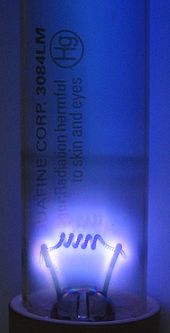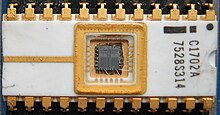
A light-emitting diode (LED) is a semiconductor light source that emits light when current flows through it. Electrons in the semiconductor recombine with electron holes, releasing energy in the form of photons. The color of the light is determined by the energy required for electrons to cross the band gap of the semiconductor. White light is obtained by using multiple semiconductors or a layer of light-emitting phosphor on the semiconductor device.

Ultraviolet (UV) is a form of electromagnetic radiation with wavelength from 10 nm to 400 nm (750 THz), shorter than that of visible light, but longer than X-rays. UV radiation is present in sunlight, and constitutes about 10% of the total electromagnetic radiation output from the Sun. It is also produced by electric arcs and specialized lights, such as mercury-vapor lamps, tanning lamps, and black lights. Although long-wavelength ultraviolet is not considered an ionizing radiation because its photons lack the energy to ionize atoms, it can cause chemical reactions and causes many substances to glow or fluoresce. Consequently, the chemical and biological effects of UV are greater than simple heating effects, and many practical applications of UV radiation derive from its interactions with organic molecules.

A fluorescent lamp, or fluorescent tube, is a low-pressure mercury-vapor gas-discharge lamp that uses fluorescence to produce visible light. An electric current in the gas excites mercury vapor, which produces short-wave ultraviolet light that then causes a phosphor coating on the inside of the lamp to glow. A fluorescent lamp converts electrical energy into useful light much more efficiently than an incandescent lamp. The typical luminous efficacy of fluorescent lighting systems is 50–100 lumens per watt, several times the efficacy of incandescent bulbs with comparable light output. For comparison, the luminous efficacy of an incandescent bulb may only be 16 lumens per watt.

A blacklight, also called a UV-A light, Wood's lamp, or ultraviolet light, is a lamp that emits long-wave (UV-A) ultraviolet light and very little visible light.
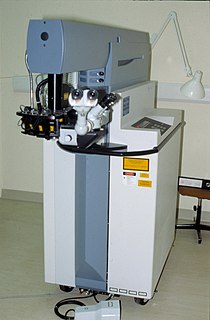
An excimer laser, sometimes more correctly called an exciplex laser, is a form of ultraviolet laser which is commonly used in the production of microelectronic devices, semiconductor based integrated circuits or "chips", eye surgery, and micromachining. Since 1960s excimer lasers are widely used in high-resolution photolithography machines, one of the critical technologies required for microelectronic chip manufacturing.

A mercury-vapor lamp is a gas-discharge lamp that uses an electric arc through vaporized mercury to produce light. The arc discharge is generally confined to a small fused quartz arc tube mounted within a larger soda lime or borosilicate glass bulb. The outer bulb may be clear or coated with a phosphor; in either case, the outer bulb provides thermal insulation, protection from the ultraviolet radiation the light produces, and a convenient mounting for the fused quartz arc tube.

A compact fluorescent lamp (CFL), also called compact fluorescent light, energy-saving light and compact fluorescent tube, is a fluorescent lamp designed to replace an incandescent light bulb; some types fit into light fixtures designed for incandescent bulbs. The lamps use a tube that is curved or folded to fit into the space of an incandescent bulb, and a compact electronic ballast in the base of the lamp.
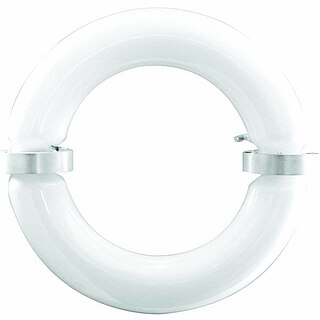
The induction lamp, electrodeless lamp, or electrodeless induction lamp is a gas-discharge lamp in which an electric or magnetic field transfers the power required to generate light from outside the lamp envelope to the gas inside. This is in contrast to a typical gas discharge lamp that uses internal electrodes connected to the power supply by conductors that pass through the lamp envelope. Eliminating the internal electrodes provides two advantages:

A xenon arc lamp is a highly specialized type of gas discharge lamp, an electric light that produces light by passing electricity through ionized xenon gas at high pressure. It produces a bright white light to simulate sunlight, with applications in movie projectors in theaters, in searchlights, and for specialized uses in industry and research. For instance, Xenon arc lamps with mercury lamps are the two most common lamps used in wide-field fluorescence microscopes.
A krypton fluoride laser is a particular type of excimer laser, which is sometimes called an exciplex laser. With its 248 nanometer wavelength, it is a deep ultraviolet laser which is commonly used in the production of semiconductor integrated circuits, industrial micromachining, and scientific research. The term excimer is short for 'excited dimer', while exciplex is short for 'excited complex'. An excimer laser typically contains a mixture of: a noble gas such as argon, krypton, or xenon; and a halogen gas such as fluorine or chlorine. Under suitably intense conditions of electromagnetic stimulation and pressure, the mixture emits a beam of coherent stimulated radiation as laser light in the ultraviolet range.

Ultraviolet photography is a photographic process of recording images by using radiation from the ultraviolet (UV) spectrum only. Images taken with ultraviolet radiation serve a number of scientific, medical or artistic purposes. Images may reveal deterioration of art works or structures not apparent under light. Diagnostic medical images may be used to detect certain skin disorders or as evidence of injury. Some animals, particularly insects, use ultraviolet wavelengths for vision; ultraviolet photography can help investigate the markings of plants that attract insects, while invisible to the unaided human eye. Ultraviolet photography of archaeological sites may reveal artifacts or traffic patterns not otherwise visible.

A deuterium arc lamp is a low-pressure gas-discharge light source often used in spectroscopy when a continuous spectrum in the ultraviolet region is needed.

Ultraviolet germicidal irradiation (UVGI) is a disinfection method that uses short-wavelength ultraviolet light to kill or inactivate microorganisms by destroying nucleic acids and disrupting their DNA, leaving them unable to perform vital cellular functions. UVGI is used in a variety of applications, such as food, air, and water purification.

Tanning lamps are the part of a tanning bed, booth or other tanning device which produces ultraviolet light used for indoor tanning. There are hundreds of different kinds of tanning lamps most of which can be classified in two basic groups: low pressure and high pressure. Within the industry, it is common to call high-pressure units "bulbs" and low-pressure units "lamps", although there are many exceptions and not everyone follows this example. This is likely due to the size of the unit, rather than the type. Both types require an oxygen free environment inside the lamp.
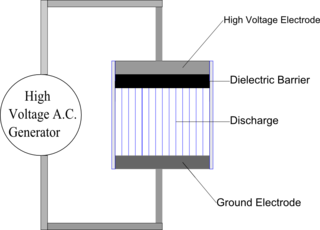
Dielectric-barrier discharge (DBD) is the electrical discharge between two electrodes separated by an insulating dielectric barrier. Originally called silent (inaudible) discharge and also known as ozone production discharge or partial discharge, it was first reported by Ernst Werner von Siemens in 1857.
The argon fluoride laser is a particular type of excimer laser, which is sometimes called an exciplex laser. With its 193-nanometer wavelength, it is a deep ultraviolet laser, which is commonly used in the production of semiconductor integrated circuits, eye surgery, micromachining, and scientific research. "Excimer" is short for "excited dimer", while "exciplex" is short for "excited complex". An excimer laser typically uses a mixture of a noble gas and a halogen gas, which under suitable conditions of electrical stimulation and high pressure, emits coherent stimulated radiation in the ultraviolet range.
An excimer lamp is a source of ultraviolet light based on spontaneous emission of excimer (exciplex) molecules.

UV curing is the process by which ultraviolet light is used to initiate a photochemical reaction that generates a crosslinked network of polymers. UV curing is adaptable to printing, coating, decorating, stereolithography, and in the assembly of a variety of products and materials. In comparison to other technologies, curing with UV energy may be considered a low-temperature process, a high-speed process, and is a solventless process, as cure occurs via direct polymerization rather than by evaporation. Originally introduced in the 1960s, this technology has streamlined and increased automation in many industries in the manufacturing sector.

Tagging of postage stamps means that the stamps are printed on luminescent paper or with luminescent ink to facilitate automated mail processing. Both fluorescence and phosphorescence are used. The same stamp may have been printed with and without these luminescent features, the two varieties are referred to as tagged and untagged, respectively.

